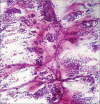Cytological Evaluation of Pathological Male Breast Lesions
- PMID: 33870108
- PMCID: PMC8025724
- DOI: 10.4274/ejbh.galenos.2020.6154
Cytological Evaluation of Pathological Male Breast Lesions
Abstract
Objective: This study aimed to determine the cytodiagnostic spectrum of various male breast lesions, which were corroborated on histopathology as appropriate, to describe the process of the cytomorphology of some uncommon pathological lesions, and to discuss the reasons of their misdiagnoses.
Materials and methods: In this 8-year study, a total of 114 patients underwent fine needle aspiration cytology (FNAC). In a representative case, nipple discharge from an 8-month-old child was examined. Confirmatory histopathology was obtained in 38 cases only.
Results: Gynecomastia was the most common (63.5%) male breast pathology. Invasive breast carcinoma of no special type was the most common variant of male breast malignancy. Half of the "gray zone" of cytological lesions was confirmed as cancer, but the rest were diagnosed as fibrocystic disease and intraductal papilloma. All cases with malignant cytology matched their corresponding histopathology. However, a tumor from an intraductal papillary carcinoma was miscued as ductal carcinoma on previous FNAC.
Conclusion: Cytological evaluation of male breast lesions provides highly sensitive and specific results with excellent histologic reproducibility. Thus, it should be the ideal pretherapeutic diagnostic procedure for male breasts. However, some benign pathological conditions, which are particularly associated with epithelial hyperplasia, perplex the cytomorphologic scenario into the "gray zone."
Keywords: Breast carcinoma; fine needle aspiration cytology; gray zone; gynecomastia; male breast.
©Copyright 2021 by Turkish Federation of Breast Diseases Associations.
Conflict of interest statement
Conflict of Interest: No conflict of interest was declared by the authors.
Figures















Similar articles
-
Utility of duct-washing cytology for detection of early breast cancer in patients with pathological nipple discharge: A comparative study with fine-needle aspiration cytology.Diagn Cytopathol. 2020 Dec;48(12):1273-1281. doi: 10.1002/dc.24572. Epub 2020 Aug 7. Diagn Cytopathol. 2020. PMID: 32767835
-
The gray zone in breast fine needle aspiration cytology. How to report on it?Acta Cytol. 2002 May-Jun;46(3):513-8. doi: 10.1159/000326870. Acta Cytol. 2002. PMID: 12040646
-
Cytology of nipple discharge in florid gynecomastia.Acta Cytol. 2003 Jan-Feb;47(1):36-40. doi: 10.1159/000326472. Acta Cytol. 2003. PMID: 12585028
-
[Needle aspiration cytology of the breast: current perspective on the role in diagnosis and management].Acta Med Croatica. 2008 Oct;62(4):391-401. Acta Med Croatica. 2008. PMID: 19205416 Review. Croatian.
-
Fine-needle aspiration cytology of in situ epithelial cell proliferation in the breast.Am J Clin Pathol. 2000 May;113(5 Suppl 1):S38-48. doi: 10.1309/8D8J-TDER-0BFX-R0JG. Am J Clin Pathol. 2000. PMID: 11993709 Review.
Cited by
-
Evaluation of Traditional Liposuction, VASER Liposuction, and VASER Liposuction Combined with J-plasma in Management of Gynecomastia.Plast Reconstr Surg Glob Open. 2024 Nov 20;12(11):e6277. doi: 10.1097/GOX.0000000000006277. eCollection 2024 Nov. Plast Reconstr Surg Glob Open. 2024. PMID: 39568685 Free PMC article.
-
Ductal carcinoma in situ of the male breast: clinical radiological features and management in a cancer referral center.Breast Cancer Res Treat. 2022 Nov;196(2):371-377. doi: 10.1007/s10549-022-06689-y. Epub 2022 Sep 17. Breast Cancer Res Treat. 2022. PMID: 36114939 Free PMC article.
-
Co-Existence of Two Rare Entities in the Male Breast: Intraductal Papilloma and Angiolipoma.Eur J Breast Health. 2022 Oct 1;18(4):371-374. doi: 10.4274/ejbh.galenos.2022.2022-1-7. eCollection 2022 Oct. Eur J Breast Health. 2022. PMID: 36248748 Free PMC article.
References
-
- Singh R, Sharma SM, Gangane N. Spectrum of male breast lesions diagnosed by fine needle aspiration cytology: A 5-year experience at a tertiary care rural hospital in central India. Diagn Cytopathol. 2012;40:113–117. - PubMed
-
- Chikaraddi SB, Krishnappa R, Deshmane V. Male breast cancers in Indian patients: Is it the same? Indian J Cancer. 2012;49:272–276. - PubMed
-
- Wauters CAP, Kooistra BW, de Kievit-van der Heijden IM, Strobbe LJA. Is cytology useful in the diagnostic workup of male breast lesions? A retrospective study over a 16-year period and review of the recent literature. Acta Cytol. 2010;54:259–264. - PubMed
-
- Rosa M, Masood S. Cytomorphology of male breast lesions: Diagnostic pitfalls and clinical implications. Diagn Cytopathol. 2012;40:179–184. - PubMed
LinkOut - more resources
Full Text Sources
Other Literature Sources
